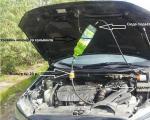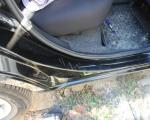How to remove small dents on the car body
Any motorist wants his “iron horse” to always look at the highest level, but sometimes even with careful and thorough care, dents and other similar defects appear on the car body (most often they are the result of an accident). Fortunately, they can be eliminated on their own, and by the way, you can save a lot of money at the same time - local body repairs at service stations are now not cheap.
An inconspicuous shallow dent on the doors or hood of a car can be quickly and easily removed using a special building hair dryer and a compressed air cylinder. Before starting work, thoroughly clean the defective area from dust and wipe it dry, dismantle the sound insulation and door trim, and raise the glass as much as possible. After that, heat the desired area of \u200b\u200bthe body well with a hair dryer, then direct the jet from the cylinder to the dent. Under air pressure, the small indentation will disappear within a few seconds. Wear protective rubber gloves when working.
To repair a deeper dent, you will need a regular hammer and a mallet (a hammer with a round rubberized head), a small block of wood and a clean, soft rag. Before starting work, completely disassemble the inner lining and dismantle the car door to get maximum access to the damaged surface from the inside. Armed with a rubber mallet, begin to carefully straighten the flaw with light tapping movements (hard blows can cause the paintwork to peel off). If the roughness cannot be straightened, wrap a wooden block with a rag, attach it to the defective surface and alternately tap it with a rubber or an ordinary hammer until the roughness is completely eliminated.
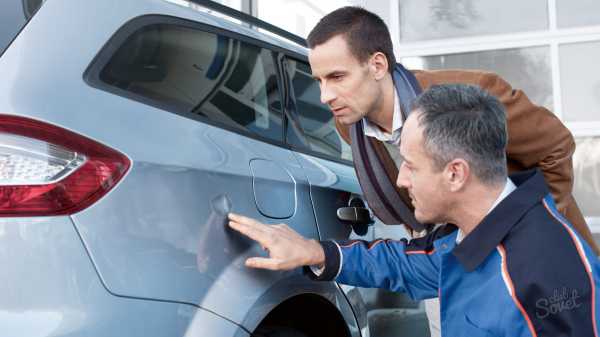
One of the most effective options for self-repair of dents on the wing and body of the car is straightening. For straightening work, you will need a jack (hydraulic or rack), a special straightening hammer, various extension cords, a powerful stop and several wooden bars. Remove the wheel from the relevant side of the vehicle before repairing the body defect. After that, place a strong stop under the jack socket. Next, put the first bar under the wing right on the stiffener, the second bar - at the rear of the car wing. Then put a suitable extension on the jack and place this structure between the wooden blocks. Start pumping the jack in the same way as when lifting the car - at this time, the air bursts the fender, due to which the dent is stretched. After fixing the jack, carefully trim the recess by lightly tapping it with a hammer from the inside of the wing (simultaneously apply support to the outer side of the wing). An important nuance: start such a repair with a stiffener and only then proceed to straightening other damaged areas! At the end of the work, it is not recommended to immediately loosen the jack, on the contrary, it is better to slightly tighten it to avoid deformation of the wing.
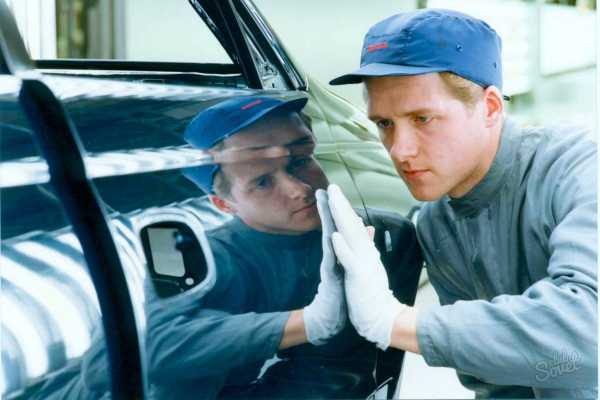
You can even out the dent with the help of a non-professional device for self-repair of body defects - suction cups with hot melt adhesive. The set of this simple device includes a special glue and a gun for heating it, several suction cups of different diameters, a bridge-bracket and a spatula for removing glue. Heat the glue with a gun, apply it to the surface of a suitable suction cup (select it according to the size of the dent). Then glue the suction cup to the defective area, and after the glue has completely cured, fix the bridge-bracket on it. Next, carefully tighten the bolt on the bracket until the unevenness is completely straightened. After that, remove the suction cup and carefully scrape off the remaining glue with a spatula. During the dent alignment procedure, it is important not to overtighten the metal so as not to damage the car's paintwork.
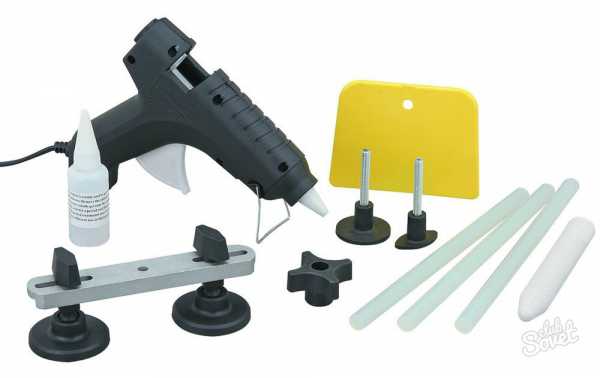
You can fix a small dent in a car fender with a football / basketball with a camera and a regular bicycle pump. Place the pre-deflated ball between the defective surface and the frame. After that, start slowly pumping up the ball - gradually filling with air, it “painlessly” for the paintwork will even out the unwanted dent. After removing the bump, deflate the ball and carefully retrieve it. Keep in mind that this method is suitable for straightening small dents that do not affect the body stiffeners.

Also, small recesses without kinks and broken edges (motorists call them "slappers") can be pulled out with an ordinary powerful magnet. Attach it to the edge of the dent and start pulling towards you (at the same time, move the magnet from the edges to the central part of the defective area with a smooth movement). To avoid damage to the paint, be sure to place a soft cloth between the magnet and the car body.
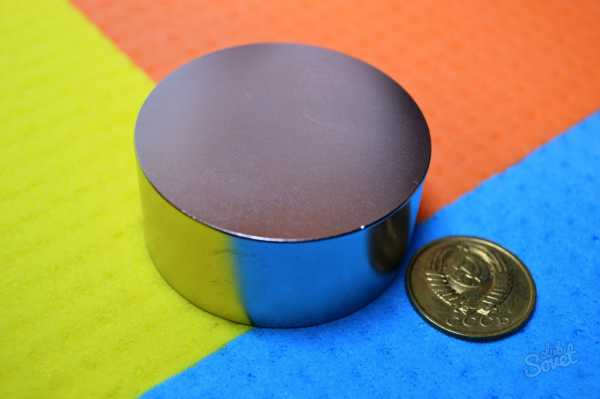
Following our instructions, even a novice motorist will be able to make minor body repairs to his “iron horse”.
SovetClub.ru
Do you want to learn how to remove dents on a car in various ways?
Every car enthusiast knows where the smallest scratches and damage are located on his car, especially if it is the latest model. But few people realize that it is possible to fix these defects by bringing the car to its original state in a few minutes. Modern technologies make it possible to repair car dents without painting and fundamental work in preparation for it - puttying, stripping, priming.
Only an experienced specialist can fix a dent on a car.
Repair of small car jams without painting
Removal of dents on a car without painting is carried out mechanically, by straightening the curvature of the body formed under the impact of impacts as a result of an accident or in another way. The mechanical restoration of the appearance of the car became possible due to the high quality of the materials used in the production process. Modern paint coatings have increased hardness combined with elasticity, therefore, in most cases, under extreme loads (when the metal base is crushed and further straightened), they do not break or crack.
In recent decades, the automotive industry has used a thinner metal that can be easily leveled. In addition, stamped metal has "shape memory" - the ability to return to the state that was originally given to it. Thanks to these features of modern materials, it became possible to remove the dent without paint, restore the previous state of the car by mechanically leveling the body. The technology came to the Russian market from the West. The advantages of this method are obvious:
- it is effective - there is a 100% restoration of the appearance;
- technology for repairing dents without painting does not provide long-term procedures: to straighten a dent on a car, it takes from 15 minutes to 2 hours, depending on the size and complexity of the damage;
- the method is economical - such repair of dents on a car is cheaper than the usual puttying and painting method, especially if the car owner has mastered the technique and can level the surface on his own;
- a high-quality result is achieved;
- the car body is processed in a sparing mode.
In what cases is it possible to remove a dent without painting?
Remember that extracting a dent on the body is possible only under certain conditions.
Removing dents on a car without painting is possible only if several conditions are met:
- earlier the car was not repaired in this place: it was neither damaged nor restored;
- no through destruction of the metal of the machine;
- the paintwork is not broken - it has been preserved intact, without breaks, deep cracks to the base, chips;
- the car is not older than 15 years.
Removing dents on a car without painting does not affect the size of the bent area - subject to the above conditions, large defects can also be corrected by this method.
Due to the design features of the car, it is impossible to remove a dent without painting with your own hands in hard-to-reach places:
- on the thresholds under the doors;
- along the edges of the trunk parts;
- on the roof racks.
To access the damage from the inside, it may be necessary to completely or partially remove the trim in the cabin.
Features body restoration by PDR method
The name of the method is literally translated from English (Paintless Dent Repair) - paintless dent removal, in speech the name is often used in the form of English (PDR) or Russian (BUV) abbreviations.
The PDR formula - paintless car body dent removal - looks like this: tool plus technology equals "massage" of a bent car body with the result of a complete "healing".
The main feature of the method is that the alignment of dents on the car requires special equipment (albeit inexpensive) and experience with it. The good news is that the technology is not difficult, so it is possible to fix defects in your own garage using do-it-yourself small dent removal tools.
PDR equipment - necessary for straightening dents on the body without painting
The enumeration of the tools used forms a long list:
- hammer;
- chipper;
- mini lifters;
- mallet;
- levers;
- hooks;
- hot glue applicators;
- vacuum suction cups;
- magnets.
Buying a professional tool for working in the PDR technique requires a lot of money, and besides, it is sold in sets. But many devices are easy to make yourself. The tools are designed to act on the damaged surface from two sides, so it is important to provide access to the curvature both from the outside and from the inside. From the outside, the dent is pulled out with the help of vacuum devices or adhesive bonding, which provides adhesion to the surface, and from the inside it is straightened with pressing movements.
Pull jam without painting - PDR technology
The repair of small dents without painting involves an exclusively mechanical method of influencing damage, for which different methods can be used using compressed air and pressure drops, magnets, thermal heating, shock-force impact.
- Removal of dents with compressed air. The use of vacuum tools is based on a strong pressure drop that pulls out dents on the car. First, the center of damage is found, a vacuum suction cup is placed on it, and the depressed area is pulled towards itself with a strong jerk, leveling the plane of the case. Usually, the method is used in combination with lever action from below.
- Removing dents with a magnet. A magnet is used to eliminate small defects, and a soft cloth is additionally placed under it so as not to scratch the coating. Move the magnet from the edge to the center, trying to stretch the concave surface.
- Removing dents using pdr technology using a hair dryer. Heating the surface with a hair dryer aims to make the metal more ductile and make it “remember” its original shape. In addition to a hair dryer, you will need a can of compressed air cooled to low temperatures (-78 ° C). First, the dent on the car is heated, then the surface is cooled by a directed contrast jet. A sharp temperature drop leads to a straightening of the concave surface - the method is called "thermal shock". If a gas cartridge is not available, you can use chilled water for this.
- Straightening dents without painting by tapping. Tapping is a universal method that is used in almost any case, since all the others do not always give a 100% result. The easiest way is to straighten those parts that can be removed from the case. The front side is protected from damage and placed down, from the wrong side, tapping is performed with a straightening hammer. Small areas are corrected from the center to the edges. If the damage is extensive, tapping starts from the edges and continues towards the center. Aligning parts that cannot be removed is a little more difficult. The master must feel the metal in order to remove the dent by tapping with a mallet. When working, the surface is protected with a soft lining so as not to damage the paintwork.
- Removing dents on a car body without painting with the help of an adhesive applicator. For this method, a mini-lifter, a special applicator and thermal glue are used. The lifter pulls out the concavity by hooking it on the applicator glued to the surface. After the procedure, the glue must be removed, it facilitates the task of spraying a special chemical composition on it.
You can’t do without a mini-lifter in such work
Do-it-yourself dent repair
Removing dents without painting at home is a profitable undertaking - it does not require the cost of consumables. Although the initial costs of purchasing equipment and training cannot be avoided, in the future, with the skills, you can remove dents on the car with your own hands within half an hour. However, it will take to hone the skill to the level of mastery.
Advice. To carry out body repairs in the PDR technique, it is necessary to develop a skill and bring it to automatism, but it is worth acquiring these skills: modern cars made of thin steel easily crumple. It is quite expensive to contact the service station every time, and the ability to fix a defect will save time, nerves and money.
The preparatory stage for removing small dents without painting with your own hands includes the purchase of a set of tools, protective equipment and the preparation of the workplace. The initial technological basics should be acquired by aligning unnecessary workpieces-body parts.
Before starting work, wash and dry the surface of the car.
In places of bending, tension is first relieved - they are tapped along the borders with a hammer, placing a metal sheet.
You can completely remove dents on the car with your own hands after mechanical tapping from the back side. To do this, you need a set of tools - levers, hooks and access from inside the body.
In the process of work, the size of the damage must be taken into account - large and small dents on the car body require different-sized devices. For damage that occupies a large area, a large diameter vacuum suction cup is required, and for small ones, small adhesive applicators and a chipper.
Do-it-yourself alignment of dents without painting is controlled only “by eye”, no devices are provided for determining the evenness of the surface and the quality of the manipulations performed.
For the accuracy of visual control in the process of repairing dents on a car, they use the effect of glare from light sources with their own hands - a flat surface reflects light evenly.
Sometimes cosmetic painting of individual areas may be required to hide scuffs or scratches, it is better in such cases to use automotive enamels in aerosol cans.
WATCH THE VIDEO INSTRUCTIONSWith the modern rhythm of life, when the car is used almost as often as one's own legs, and the number of unforeseen situations on the roads, damages, car bumps is growing, mastering the BUV method - removing dents without painting pdr - can be a help that saves a lot of your own time and money.
krasimavtomobil.ru
We remove dents on the car in various ways
Due to various traffic accidents, various dents may remain on the body or bumper of the car. They spoil the appearance of the car and cause a lot of trouble, because a car is not only a vehicle, but also an indicator of the status of its owner. dent
A dent is a deformation of the body, as a result of which the integrity of the car's paintwork is violated and corrosion processes can begin to develop at the defect site. Repairing dents is more difficult than, for example, removing small scratches and chips.
In addition, the cost of such a service in a car service is quite high. But there are some ways that will help get rid of dents without painting and with your own hands.
Modern methods of removing dents without repainting the car are becoming more and more popular. This is primarily due to the fact that foreign cars have a different body type than older car models.
Their paintwork contains special additives (polymers), making it more flexible. This property allows you to maintain the integrity of the coating even after a small accident or damage to the body.
Paintless dent repair
This type of repair has many advantages:
- It is possible to remove a dent or body defect in a short period of time (no more than 15 minutes).
- Thanks to the use of this technology, the integrity of the oxide film on the surface of the car body is not violated (thus, the possibility of corrosion is practically eliminated).
- Carrying out repairs is possible without dismantling the car and removing parts that need repair.
- Alignment of dents without painting is carried out without tinting and re-painting the car, which means that you can completely eliminate the possibility of an error when choosing a color for painting over a defect.
- Such repairs are much cheaper than regular body repairs, and there is no need to pay for painting and car painter services.
Features of dent restoration
All damages and defects of the body are eliminated by mechanical action on the deformed area, while the rest of the body does not suffer.
It is possible to carry out such a procedure due to the fact that the body metal has a kind of memory and remembers the original shape that it had immediately after it was formed. As a result of the repair, the body acquires its original shape.
It is necessary to carry out such repairs very carefully, necessarily feeling the features of the metal. Also, the master must be able to properly work with the necessary tool for leveling. You need to act on the dent very carefully so as not to provoke cracking of the applied paintwork of the car.
You need to know that the elimination of dents without painting is not possible in all cases of damage to the body. If there are violations of the integrity of the paintwork, it has peeled off and the metal is visible, in cases where the metal of the body is severely deformed or destroyed through and through, repairs without painting are not carried out. Also, do not engage in pulling dents if this place has already been restored after damage.
In the process of work, the master uses special tools: levers, which are made of high quality steel of various sizes. It is imperative to act on the defect from both sides (from the outside, the dent is eliminated with the help of adhesive systems and various vacuum suction cups).
PDR technology
Has a lot of advantages:
- The paintwork applied at the factory cannot be removed.
- There is no need to treat the body with abrasive materials and putties, as well as to select the desired shade of paint for a long time.
- Alignment of dents without painting, the price will be several times lower than if the whole range of painting work was carried out.
- It will take no more than 2 hours to eliminate defects.
This method does not involve the use of a large number of consumables and the master does not have to work for a long time to eliminate the defect.
Car dent removal
PDR technology can only be applied if the integrity of the paintwork was not violated during damage to the body.
The procedure is quite inexpensive because no expensive work is carried out to prepare the car for painting and the actual application of the paintwork is not carried out.
In addition, in this case, it is very rarely necessary to resort to dismantling a damaged body part (in most cases, a defect can be eliminated without violating the integrity of the vehicle's factory assembly). That is why the removal of dents on a car without painting has become more and more popular lately.
How to pull out a dent without painting
Car owners often wonder what kind of dents can be pulled out without painting? In this case, you need to pay attention to the nature of the damage - if the paintwork at the site of the defect has peeled off or there are through holes in the body, it is necessary to engage in partial body repairs. Ways to fix dents:
- Mechanical straightening.
With it, you can easily eliminate defects in such hard-to-reach places of the body, where it is impossible to use a special tool for repairing dents without painting. In the process of work, the master uses special levers and special vacuum hoods (most often they are used to eliminate minor damage to the car body). In this case, it is possible to return the body to its original shape due to a strong pressure drop. The lever, which fits perfectly in size, is immersed in a special technological hole on the body, then with light pressure movements, the master returns the concave metal to its place. The procedure must be carried out very carefully, controlling the process and making sure that no edges are formed. If you can get close to the defect from the inside, you can straighten the dent with ordinary pressure. The metal will return to its original place with a characteristic click.
- Straightening external with the help of special equipment.
The master fixes a special applicator on the damaged area with glue. Pulling out dents without painting can be carried out only after the adhesive has completely dried. The defect is leveled with a special mini-lifter, then the adhesive residues are removed from the body. Usually this technique is used in cases where it is not possible to get close to the dent from the inside. You can remove the defect with your own hands, without using professional devices for this. All you need is a suction cup with hot melt adhesive, the principle of which is that it sticks to the dent, and after the glue dries, it straightens the defect.
- Alignment with a magnet.
To remove dents without painting, if they are small, you can use a regular magnet. The magnet must be moved from the edges to the center of the dent, slightly bringing it closer to you. Beforehand, you can put a piece of soft, lint-free cloth under the magnet to avoid scratches on the paintwork of the body. As a result, you can achieve the elimination of small dents without painting.
This principle of eliminating defects is based on the ability of the metal to take the original shape that was given to it at the time of manufacture. The master must first protect the eyes with special glasses and prepare a can of compressed air (its temperature is -78C). The defect is heated with a building hair dryer, and then a jet of cooled air from a can is sharply directed onto the heated surface. The dent on the body of the vehicle is leveled due to a sharp change in temperature, but in some cases it will be necessary to warm the dent along its entire radius.
If it was not completely possible to cope with the dent with a hair dryer, they resort to percussion. A piece of soft (preferably rubberized) material is applied to the paintwork, then tapping is carried out with a mallet.
Do-it-yourself dent repair without painting
Local body repair will no longer require the use of a welding machine to restore the body, the entire range of preparatory work (cleaning the surface of the body, its puttying and grinding, priming), as well as the final application of the paintwork.
Before starting a dent repair
Thanks to the pulling of dents without painting, body defects can be eliminated, and there will be no visible marks left at the place of restoration work.
It will be problematic for a beginner to carry out such repairs, in addition, it is necessary to have special tools. But you can buy such a set in a specialized car shop and learn all the intricacies of pulling dents.
You can study the theory of repair using training videos on the Internet, as well as on our website, so that there are no more doubts - practice on an unnecessary part of the car body. Repair should be carried out in stages:
- The working surface must be cleaned before repairing - wash and wait for it to dry.
- In all places of bending, it is necessary to carefully remove the tension. For this, cores and a special hammer are used.
- You can straighten the dent with a vacuum or glue.
- Then you need to straighten the remaining dents. It is better to do this from the inside of the body (if there is access) using special hooks.
If the dent is large enough, a special suction cup is placed on it, and adapters are glued to small defects. You can level the dent manually or use a mini-lifter for this. The metal must be tightened to a certain level, so the surface of the body is completely restored.
All small irregularities can be removed with a chipper (such devices are made of a special material and have a cigar shape). It is necessary to control the process of leveling the dent visually, so you need to work in good light.
The shape of the reflections of light reflected from the surface can determine the level of distortion of the case and the general degree of irregularities that need to be corrected.
It is possible to influence the defect from the inside with the help of special mechanical levers, which are equipped with a handle for more convenient use. If there is no access to the damaged area, it makes sense to dismantle the body part to carry out all the necessary work.
After all restoration work to remove dents from the car body has been completed, the treated area can be further polished.
topreit.ru
Six Proven Ways to Repair a Dent in Your Car
There are several ways to straighten dents, based on the use of various tools. At the same time, these works are carried out according to one principle, which consists in the fact that the body in the damaged area is subjected to physical impact. This article discusses the basic methods for leveling the car body.
Mechanical alignment from the inside
The use of this technology allows you to even out defects without painting. In this case, vacuum hoods and levers are used. Alignment of dents on the car body in this way is based on the pressure difference. The work consists in the fact that a lever of suitable size, that is, reaching the defect, is placed in the technological hole of the car body and pressed on it until the damaged area returns to its original state. The return of the material to its original state is usually accompanied by a click.
Pressure must be applied carefully to prevent the metal from bending in the opposite direction. If this happens, the area can be leveled with a fluoroplastic chipper.
If the dent is located close to the body opening, then pressure can be applied to it from the inside without using a lever. However, the car body is not always damaged near the technological holes, and it can be problematic to get close to the defect from the inside. In the absence of such an opportunity, the alignment of damage is carried out by one of the methods discussed below.

